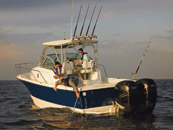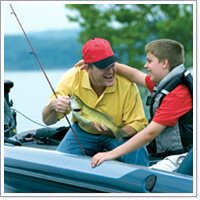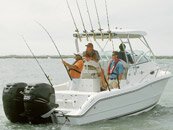Are you new to saltwater fishing, or a seasoned angler looking for a new boat? Read our guide on saltwater fishing boats.
Saltwater Fishing
Some 15 million Americans list saltwater fishing as one of their preferred recreational activities. In some respects, saltwater is a misnomer; marine might be
a better term... Many of this country’s finest non-freshwater fishing venues are only partially salty. Additionally, many of the most prized sport fishing species--salmon, steelhead trout, shad, and striped bass--are anadromous--they breed in fresh water, spend part of their life in the ocean, and then move back to fresh water to spawn.
Seawater or saltwater is a general term for water that has a significant concentration of dissolved salts and solids, generally more than 30 parts per thousand (ppt). Saltiness varies widely from place to place and over time. Marlin, tuna, sharks, and bluefish are popular seawater species.
Brackish Water Fishing
Brackish water has more dissolved salts and solids than freshwater, but is not as salty as seawater and may result from mixing freshwater and seawater in estuaries such as the Chesapeake Bay or Puget Sound. For sport anglers, brackish waters hold a range of fishing possibilities. The most important brackish water habitats are estuaries, where rivers meet the sea.
Brackish water has between 0.5 and 30 grams of salt per liter, or more commonly 0.5 to 30 ppt, a range of saltiness rather than a precisely defined condition. The salinity of many brackish surface waters varies considerably over time and distance. Heavy rains inland and upriver can send a “slug” of freshwater coursing down the length of an estuary, altering the salinity along the way. Prolonged drought can have the reverse effect.
The term freshwater refers to bodies of water that have low concentrations of dissolved salts and other dissolved solids, usually less than 0.5 parts per thousand (ppt) of salt. Trout, bass, crappie, pickerel, walleye, and muskie, among other popular sport species, usually live in freshwater.
The types of fishing that you try, along with the venues you choose, determine the gear that you need. What works in one spot, for one species, may not work down the bay, up the coast, or for another kind of fish. Fly fishing for false albacore in the surf in North Carolina requires different gear than trolling for stripers on the Pacific Coast or casting for redfish on a Gulf bayou.
Volumes have been, and are still being written about selecting marine fishing gear. While saltwater fishing gear is similar to freshwater gear, there are certain basic differences. Saltwater gear tends to be heavier and more durable. The metal parts are treated to resist corrosion. Regardless the types of fishing you try and the waters you frequent, certain basic criteria hold true.
Fishing Rods, the Essential Tool
In its essence, a fishing rod is a stick used to dangle a string that terminates in a hook used to catch fish. A modern fishing rod is generally a more sophisticated casting tool fitted with line guides and a reel for storing line. Fishing rods vary in thickness, flexibility, and length, and can be 2 to 20 feet long. The longer the rod, the greater the mechanical advantage in casting.
A fishing rod also extends the angler’s reach and leverage. Essential to casting and presenting the bait or lure to attract fish, the rod absorbs the shock of a fish striking and helps set the hook and play and land the fish. Rods also hold the reel and guide the line on and off the spool.
Rods are generally fitted with guides, wire loops that direct the line to the tip-top, the guide at the top of the rod. Grips are the part of the rod that you hold in your hand, usually made of synthetic EVA foam, or cork on good casting rods. The seat holds the reel, usually using some form of screw ring or lock device.
Use spin casting rods for active styles of fishing where you frequently cast and retrieve the bait or lure. Conventional spinning rods are heavier and suited to fishing for larger fish such as striped bass, steelhead, and salmon. Surfcasting rods can run more than a dozen feet long, with massive construction to hurl a heavily weighted lure or bait out beyond the surf’s breakers. Fly fishing rods are making an appearance in the marine environment. Long, thin, flexible, and lightweight, they are designed to cast flies, usually streamers in marine venues.
Surfcasters may require super-tall poles of 15 feet or more, while trolling for large tuna or other big game fish requires a shorter, stiffer rod, not suitable for casting. Most spinning and casting rods range from 5.5 to 7.5 feet. Fiberglass is the most economic material for fishing rods; graphite is lighter, stiffer and more sensitive but also pricier. Regardless the type of fishing you enjoy, match your rod, reel and tackle to improve your chances of making a catch. For novices and casual anglers, a prepackaged combination of rod, reel, and tackle enables you to spend more time actually fishing.
Fishing Reels
Fishing reels store, deploy, and retrieve fishing line. They increase your mechanical advantage to handle strong fish and have a “drag” system used to pressure a fish during a fight. The first American fishing reel was invented around 1820, a bait caster that quickly became popular. Bait casting reels store line on a revolving spool and are mounted above the rod. Their spools sit perpendicular to the rod and range in size from compact to massive multi-speed offshore saltwater reels, weighing many pounds. They require a bit more technique when casting to avoid backlash and tangled lines.
Spinning reels are the easiest for most anglers to use and are suitably robust for midweight marine fishing. They have a fixed spool set below and parallel with the rod and were originally designed to throw artificial flies and lures to trout and salmon. The fixed spool solved the backlash problem and later models proved sturdy enough to handle larger baits and larger catches. Spinning reels are an excellent choice for light tackle and easy to use by casual and beginning anglers.
The spin cast reel addresses the bait casting reel’s backlash and reduces the line twist and snaring sometimes encountered with spinning reels. Traditionally mounted above the rod, the spin cast reel—sometimes called a closed face spinner--is fitted with a metal cup and an external nose cone enclosing the fixed, parallel spool. Primarily a freshwater tool, “closed-face spinners” may show up primarily casting from piers and into brackish backwaters.
Fly casting reels are relatively simple and serve more to store the line than to mechanically assist playing the fish.
Regardless the type, reels intended for marine use are pricier because they use corrosion-resistant materials such as anodized aluminum, shielded stainless steel, or bronze bearings and forged aluminum spools. Quality reels also use sealed ball bearings for a smoother action. A rod and reel work together to form a system. Choose a reel is to match the rod you’ll be using. Buying a rod and reel combination can be a wise shortcut to getting yourself out on the water catching fish.
Natural Baits, the Most Effective Choice
One of the most efficient and productive methods of sport angling is to use natural baits. Natural baits are effective because of their familiar texture, odor, and color, and require a relatively simple presentation. They are generally most effective when acquired locally, outweighing any hassles involved in obtaining them. Some of the more popular natural baits include bloodworms, clam worms, clams, crabs of all kinds, eels, sand fleas, shrimp, and squid.
Many marine anglers vow that if you really want to catch fish, particularly big fish, live bait is the only way to go. Dead cut bait will work, but not as well. While lures out-fish live bait in certain situations, live bait is the best way to deliver what the fish really want to eat. Live baits including croaker, ballyhoo, killifish, saltwater minnows, ladyfish, menhaden, mullet, pinfish, and sardines, can be presented with a variety of tackle and techniques. Bait casting, jigging, bottom fishing, and trolling all lend themselves to using live and natural baits.
Artificial Baits - The Challenge of Using Lures
Some anglers prefer to use artificial baits or lures, made to imitate prey or prey characteristics such as color, flash, or shape that fish find attractive. A quick look down the aisle at your local tackle shop will tell you that artificial baits come in a bewildering array of styles, shapes, strategies, and colors, ranging from simple silver spoons to complex parachutes, daisy chains, and umbrella rigs, or massive, feathered teasers trolled for open-ocean billfish.
Seasoned anglers usually carry more than one kind of lure and try to cover as much of the water column as possible: surface, subsurface and bottom. Specific lures for each zone and species enable you to get attractive baits to the fish regardless where it is holding. There are hundreds of different types of artificial lures, but most fall into one of five basic categories: trolling lures and skirts, hard baits, jigging spoons, bucktail jigs, and soft plastics.
Types of Lures
- Trolling lures - are extremely popular for big game saltwater fishing. Trolling enables anglers to cover a lot of water and find the active fish. Carry a variety of lures so you can adapt to what the fish are feeding on.
- Hard baits - is a term that encompasses crankbaits, topwater lures, stickbaits, and other hard baits that imitate bait fish. These lures are very effective around piers, canals, inlets, rivers and in the surf, especially when retrieved with a twitch and pause motion.
- Jigging spoons - are one of the most popular—and traditional--saltwater lures, used from boats, off of piers and in the surf. They work because they resemble a wounded baitfish, flapping and fluttering. Jigging spoons are fairly heavy, enabling long casts and quick descents to the proper depths.
- Bucktail - jigs have a jighead and some type of hair or feathering that covers the hook. Attractive to a variety of species, heavier bucktails work in deeper water. Tipping the bucktail with shrimp, cut bait, or live bait can increase your chances for a catch. You can also effectively cast these jigs around piers, inlets, rivers, and in the surf.
- Soft plastics - for saltwater generally resemble crabs, shrimp, minnows and small bait fish--the primary food for bigger fish. If soft plastics are your choice, select the forage that fish are feeding on in your area.


